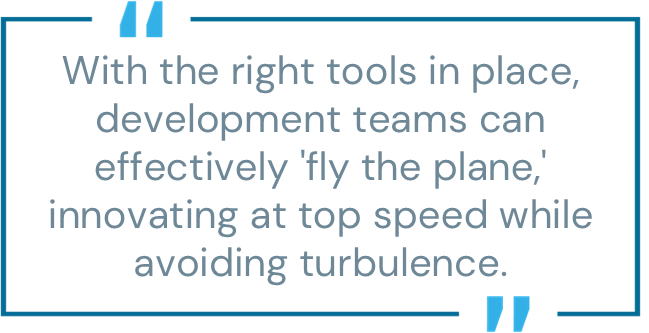Developers fly the plane: AI guardrails for secure cloud innovation

Developers now chart courses through environments as dynamic and unpredictable as open skies, plotting efficient courses through shifting clouds of technology to reach ambitious goals. Increasingly, AI assistants are copilots on these journeys—streamlining workflows, reducing repetitive tasks, and enabling teams to navigate more complex terrain with speed.
Yet, as organizations embrace agentic AI—autonomous systems able to execute tasks independently—new operational horizons open, introducing both efficiency and heightened risk. At the center of this transformation, Model Context Protocol (MCP) servers function as a critical navigation system, streamlining the creation of AI-agents and workflows powered by large language models (LLMs). With these advancements, teams can reach new altitudes in innovation.
But no successful flight is without the need for guardrails. The rapid adoption of MCP servers, while accelerating progress, demands rigorous safeguards to reduce turbulence and maintain safe control of the journey.
AI-powered development: Balancing opportunity and risk
Accelerated innovation through AI offers organizations the chance to disrupt markets, improve operational efficiencies, and gain competitive advantages. However, speed without security can open the door to significant risks. This is especially true for MCP servers, which, while facilitating agile development, can introduce new vulnerabilities:
- Overprivileged identities and unmanaged agents often operate with standing access, creating an attractive target for attackers.
- These conditions expose teams to risks across hybrid and multi-cloud environments, increasing the attack surface.
- Snowballing vulnerabilities can lead to audit failures, breaches, and costly penalties.
For cybersecurity leaders, these risks highlight the importance of establishing guardrails for AI-powered development that balance rapid innovation with critical oversight. This can help to ensure progress remains unencumbered by security setbacks.

Developer speed meets security control
Earlier, we compared developers at the forefront of AI innovation to pilots—tasked with charting fast, efficient paths through increasingly complex digital airspace. Just as pilots must steer through changing conditions while delivering passengers safely to their destinations, developers must build and deploy at high velocity while minimizing risk. In this analogy, security teams play the critical role of air traffic control: providing oversight, establishing boundaries, and coordinating movements across a crowded, dynamic environment.
This balance of speed and control becomes even more complex as autonomous AI “autopilot” systems assume responsibility for intricate navigation decisions. Cloud-native environments demand that organizations enable rapid innovation—allowing developers to “fly the plane” confidently—without relinquishing necessary security controls. Precise, well-placed guardrails can help developers stay on course, even as digital landscapes and workloads evolve.
By implementing identity security strategies tailored for cloud-native operations, organizations can create the conditions for developers and security teams to work in concert—advancing innovation while maintaining robust oversight.
Clear skies ahead with MCP and ZSP
Modern cloud teams depend on AI assistants to automate workflows, accelerate access, and streamline coding tasks. However, achieving seamless integration with native developer tools while promoting enterprise-wide security compliance is key. This is where MCP servers and zero standing privileges (ZSP) come together, creating a powerful synergy to advance AI adoption securely.
The magic of this pairing lies in their ability to balance contextual access with dynamic privilege enforcement. Here’s how they work:
- Task-based access: AI automates the elevation of privileges for task-based access through the MCP server.
- Real time evaluation: ZSP evaluates each request in real time, granting permissions only for the precise scope and duration needed.
- Auditable actions: Throughout the process, full audit trails are maintained.
- Dynamic revocation: Once tasks are complete or conditions change, access is automatically revoked with ZSP.
By utilizing this workflow, organizations can benefit from several key outcomes:
- Reduced security risk: AI systems avoid standing privileges, minimizing the risk of exploitation.
- Accelerated AI adoption: Security teams support faster adoption with confidence, while developers integrate AI capabilities seamlessly within their workflows.
- Streamlined productivity: Developers experience minimal friction during entitlement escalation, maintaining momentum in their tasks.
By routing all access requests through ZSP policies, MCP servers establish a foundation of policy-driven cloud access. Tools like Command Line Interface (CLI), Integrated Development Environments (IDEs), and native AI assistants integrate these capabilities directly into developers’ ecosystems, preserving user experience while enhancing security.
Empowering innovation with AI guardrails
The combination of MCP servers’ contextual awareness and ZSP’s dynamic access control create an effective identity security strategy for the AI era. This framework enables organizations to scale AI capabilities confidently while safeguarding development processes. By effectively managing privileges and securing AI systems, leading enterprises can strike the ideal balance of autonomy and oversight.
Cybersecurity leaders must think of their role as setting the guardrails to promote secure system operations without disrupting progress. With the right tools in place, development teams can effectively “fly the plane,” innovating at top speed while avoiding turbulence.
Discover how CyberArk Secure Cloud Access (SCA) MCP Server can help protect developers and enable secure AI adoption.
Brooke Jameson is a senior product marketing manager at CyberArk.